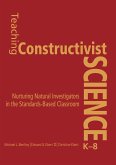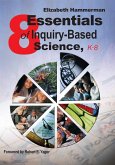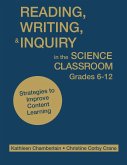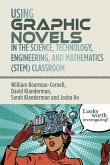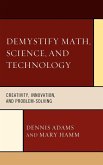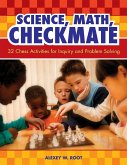Sally Berman
Thinking Strategies for Science, Grades 5-12
Sally Berman
Thinking Strategies for Science, Grades 5-12
- Broschiertes Buch
- Merkliste
- Auf die Merkliste
- Bewerten Bewerten
- Teilen
- Produkt teilen
- Produkterinnerung
- Produkterinnerung
With reproducibles and a new section on designing activities, this revised edition presents strategies and standards-aligned lessons that strengthen student comprehension and higher-level thinking skills in science.
Andere Kunden interessierten sich auch für
![Teaching Constructivist Science, K-8 Teaching Constructivist Science, K-8]() Michael L. BentleyTeaching Constructivist Science, K-891,99 €
Michael L. BentleyTeaching Constructivist Science, K-891,99 €![Eight Essentials of Inquiry-Based Science, K-8 Eight Essentials of Inquiry-Based Science, K-8]() Elizabeth HammermanEight Essentials of Inquiry-Based Science, K-840,99 €
Elizabeth HammermanEight Essentials of Inquiry-Based Science, K-840,99 €![Reading, Writing, and Inquiry in the Science Classroom, Grades 6-12 Reading, Writing, and Inquiry in the Science Classroom, Grades 6-12]() Kathleen ChamberlainReading, Writing, and Inquiry in the Science Classroom, Grades 6-1235,99 €
Kathleen ChamberlainReading, Writing, and Inquiry in the Science Classroom, Grades 6-1235,99 €![The Edinburgh Journal of Science, Volume 2 The Edinburgh Journal of Science, Volume 2]() David BrewsterThe Edinburgh Journal of Science, Volume 240,99 €
David BrewsterThe Edinburgh Journal of Science, Volume 240,99 €![Using Graphic Novels in the Science, Technology, Engineering, and Mathematics (Stem) Classroom Using Graphic Novels in the Science, Technology, Engineering, and Mathematics (Stem) Classroom]() William Boerman-CornellUsing Graphic Novels in the Science, Technology, Engineering, and Mathematics (Stem) Classroom85,99 €
William Boerman-CornellUsing Graphic Novels in the Science, Technology, Engineering, and Mathematics (Stem) Classroom85,99 €![Demystify Math, Science, and Technology Demystify Math, Science, and Technology]() Dennis AdamsDemystify Math, Science, and Technology138,99 €
Dennis AdamsDemystify Math, Science, and Technology138,99 €![Science, Math, Checkmate Science, Math, Checkmate]() Alexey W. RootScience, Math, Checkmate49,99 €
Alexey W. RootScience, Math, Checkmate49,99 €-
-
-
With reproducibles and a new section on designing activities, this revised edition presents strategies and standards-aligned lessons that strengthen student comprehension and higher-level thinking skills in science.
Hinweis: Dieser Artikel kann nur an eine deutsche Lieferadresse ausgeliefert werden.
Hinweis: Dieser Artikel kann nur an eine deutsche Lieferadresse ausgeliefert werden.
Produktdetails
- Produktdetails
- Verlag: Corwin
- 2. Auflage
- Seitenzahl: 144
- Erscheinungstermin: 19. Juni 2008
- Englisch
- Abmessung: 280mm x 216mm x 8mm
- Gewicht: 382g
- ISBN-13: 9781412962896
- ISBN-10: 1412962897
- Artikelnr.: 23388225
- Herstellerkennzeichnung
- Libri GmbH
- Europaallee 1
- 36244 Bad Hersfeld
- gpsr@libri.de
- Verlag: Corwin
- 2. Auflage
- Seitenzahl: 144
- Erscheinungstermin: 19. Juni 2008
- Englisch
- Abmessung: 280mm x 216mm x 8mm
- Gewicht: 382g
- ISBN-13: 9781412962896
- ISBN-10: 1412962897
- Artikelnr.: 23388225
- Herstellerkennzeichnung
- Libri GmbH
- Europaallee 1
- 36244 Bad Hersfeld
- gpsr@libri.de
Sally Berman specializes in teaching educators how to use practical strategies that expand student teamwork, cognition, metacognition, and self-evaluation skills. She developed and tested many of her ideas during her 30 years of teaching science in a large Chicago-area high school. Berman regularly presents at workshops and conferences and has taught graduate courses for SkyLight Professional Development in conjunction with St. Xavier University and Cumberland University.
Preface
Acknowledgments
About the Author
Introduction
Part I. Gathering Information
1. The People Search: Getting to Know You
2. KNL: What Do We Know? What Do We Need to Know? What Have We Learned?
3. Asking Questions: What I Really Do Not Understand Is...
4. The Prediction Guide: Becoming More Focused Readers
5. The Importance of Using Precise Labels: Latch Onto a Label
6. Think-Pair-Share: And the Answer Is. . .
7. Making Observations: It Makes Cents to Me
8. Accurate Observations: Hide in Plain Sight
Part II. Processing Information
9. Mental Modeling: What Is Behind Door Number Two?
10. Becoming Better Listeners: What a Bright Idea
11. The Venn Diagram: Frogs and Salamanders
12. Using a Fishbone: The Planets Organized
13. One Way to Use a Matrix: That Is My Pet Matrix
14. Looking for Attributes: Scavenger Hunt
Part III. Analyzing and Applying Information
15. Lateral Thinking: Cook¿s Choice
16. An Individual Writing Activity: Dear Uncle Chester
17. A Jigsaw: Elements, Compounds, and Mixtures
18. Follow-Up for Guided Practice: Elements, Compounds, and Mixtures
19. Using a Storyboard: Home on the Range Just Is Not the Same
20. Mapping: Making Sense of What We Know
21. Right-Angle Thinking: Molecules in Motion
Part IV. Designing Your Own Activities
22. Designing Your Own Activities: Your Turn!
Reproducibles
References and Recommended Readings
Index
Acknowledgments
About the Author
Introduction
Part I. Gathering Information
1. The People Search: Getting to Know You
2. KNL: What Do We Know? What Do We Need to Know? What Have We Learned?
3. Asking Questions: What I Really Do Not Understand Is...
4. The Prediction Guide: Becoming More Focused Readers
5. The Importance of Using Precise Labels: Latch Onto a Label
6. Think-Pair-Share: And the Answer Is. . .
7. Making Observations: It Makes Cents to Me
8. Accurate Observations: Hide in Plain Sight
Part II. Processing Information
9. Mental Modeling: What Is Behind Door Number Two?
10. Becoming Better Listeners: What a Bright Idea
11. The Venn Diagram: Frogs and Salamanders
12. Using a Fishbone: The Planets Organized
13. One Way to Use a Matrix: That Is My Pet Matrix
14. Looking for Attributes: Scavenger Hunt
Part III. Analyzing and Applying Information
15. Lateral Thinking: Cook¿s Choice
16. An Individual Writing Activity: Dear Uncle Chester
17. A Jigsaw: Elements, Compounds, and Mixtures
18. Follow-Up for Guided Practice: Elements, Compounds, and Mixtures
19. Using a Storyboard: Home on the Range Just Is Not the Same
20. Mapping: Making Sense of What We Know
21. Right-Angle Thinking: Molecules in Motion
Part IV. Designing Your Own Activities
22. Designing Your Own Activities: Your Turn!
Reproducibles
References and Recommended Readings
Index
Preface
Acknowledgments
About the Author
Introduction
Part I. Gathering Information
1. The People Search: Getting to Know You
2. KNL: What Do We Know? What Do We Need to Know? What Have We Learned?
3. Asking Questions: What I Really Do Not Understand Is...
4. The Prediction Guide: Becoming More Focused Readers
5. The Importance of Using Precise Labels: Latch Onto a Label
6. Think-Pair-Share: And the Answer Is. . .
7. Making Observations: It Makes Cents to Me
8. Accurate Observations: Hide in Plain Sight
Part II. Processing Information
9. Mental Modeling: What Is Behind Door Number Two?
10. Becoming Better Listeners: What a Bright Idea
11. The Venn Diagram: Frogs and Salamanders
12. Using a Fishbone: The Planets Organized
13. One Way to Use a Matrix: That Is My Pet Matrix
14. Looking for Attributes: Scavenger Hunt
Part III. Analyzing and Applying Information
15. Lateral Thinking: Cook¿s Choice
16. An Individual Writing Activity: Dear Uncle Chester
17. A Jigsaw: Elements, Compounds, and Mixtures
18. Follow-Up for Guided Practice: Elements, Compounds, and Mixtures
19. Using a Storyboard: Home on the Range Just Is Not the Same
20. Mapping: Making Sense of What We Know
21. Right-Angle Thinking: Molecules in Motion
Part IV. Designing Your Own Activities
22. Designing Your Own Activities: Your Turn!
Reproducibles
References and Recommended Readings
Index
Acknowledgments
About the Author
Introduction
Part I. Gathering Information
1. The People Search: Getting to Know You
2. KNL: What Do We Know? What Do We Need to Know? What Have We Learned?
3. Asking Questions: What I Really Do Not Understand Is...
4. The Prediction Guide: Becoming More Focused Readers
5. The Importance of Using Precise Labels: Latch Onto a Label
6. Think-Pair-Share: And the Answer Is. . .
7. Making Observations: It Makes Cents to Me
8. Accurate Observations: Hide in Plain Sight
Part II. Processing Information
9. Mental Modeling: What Is Behind Door Number Two?
10. Becoming Better Listeners: What a Bright Idea
11. The Venn Diagram: Frogs and Salamanders
12. Using a Fishbone: The Planets Organized
13. One Way to Use a Matrix: That Is My Pet Matrix
14. Looking for Attributes: Scavenger Hunt
Part III. Analyzing and Applying Information
15. Lateral Thinking: Cook¿s Choice
16. An Individual Writing Activity: Dear Uncle Chester
17. A Jigsaw: Elements, Compounds, and Mixtures
18. Follow-Up for Guided Practice: Elements, Compounds, and Mixtures
19. Using a Storyboard: Home on the Range Just Is Not the Same
20. Mapping: Making Sense of What We Know
21. Right-Angle Thinking: Molecules in Motion
Part IV. Designing Your Own Activities
22. Designing Your Own Activities: Your Turn!
Reproducibles
References and Recommended Readings
Index


